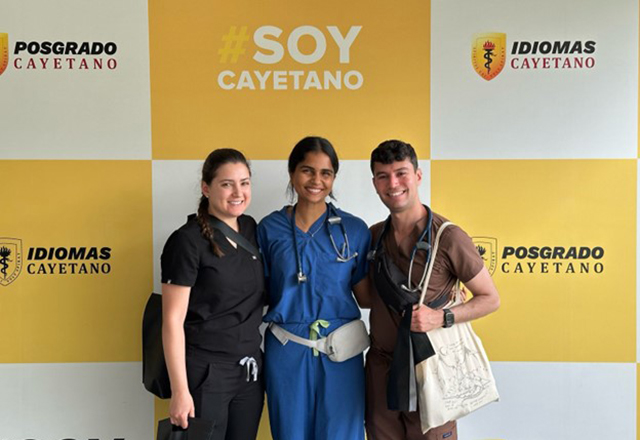This blog is a collaboration between medical students Vennela Avula and Ariel Vilidnitsky.
As part of the Global Health Leadership Program at the Johns Hopkins University School of Medicine, we recently spent five weeks at a public hospital in Peru. Vennela rotated in the adult cardiology department, while Ariel rotated in pediatrics. Here are some of the insights we gained:
Medicine in a Resource-Constrained Context. One of the most striking characteristics of medical care at this hospital is that it operates under rigid constraints. For context, this hospital is for patients covered by Seguro Integral de Salud (SIS), Peru’s public insurance system, which is funded through general taxes. SIS primarily targets those in poverty, providing free health care for certain conditions and covering about 65% of the population [1]. However, coverage limitations often force physicians to make difficult decisions about patient care. For example, a commonly used medication for constipation in the United States is not covered by SIS, so doctors rely on lactulose instead, despite a worse side-effect profile. Moreover, due to limitations in personal protective equipment, providers reuse and share one allotted single-use gown per patient, with contact precautions. The hybrid record-keeping system is equally telling: a mix of paper charts, a simple electronic medical record, and smartphone photos of lab results and imaging.
Evidence-Based Medicine. Admittedly, we initially assumed that resource scarcity might lead to outdated medical practices. As we got to know the hospital better, however, we were impressed by the providers’ commitment to evidence-based care. For example, three mornings a week, residents on the cardiology service presented American Heart Association and European Society of Cardiology best practice guidelines for a variety of pathologies. These discussions typically focused on how to effectively adapt these guidelines to the unique circumstances of their hospital, such as managing acute heart attacks with only one interventional cardiologist available to perform percutaneous coronary interventions. Physicians often took on new roles to meet the needs of the patients. General cardiologists, for instance, learned how to perform pacemaker placements. Meanwhile, with only one functioning endoscopy machine, pediatric gastroenterologists had to make judicious use of gaps in the adult gastroenterologists’ procedure schedule to fit in their most urgent patients. This ethos of adaptability was something that textbooks couldn’t teach us and was among the most humbling aspects of our experience.
Family As a Cornerstone of Care. Beyond medical practice, we noticed fundamental cultural differences in health care delivery, compared with the United States. Family members were expected to accompany elderly patients to appointments; coming alone signaled a lack of support and sometimes raised eyebrows. In the inpatient setting, families were responsible for purchasing and delivering essential medical supplies. Even basic procedures, like echocardiograms, could be delayed until a family member obtained necessary materials, such as electrodes. This highlighted how deeply patient care was intertwined with family support, likely reflecting the prevalence of multigenerational households.
Rare Pathologies and Clinical Reasoning. Certain patients etched themselves into our memories. A 15-year-old boy with Chagas disease who developed heart block and required a pacemaker. A 36-year-old woman with rheumatic heart disease leading to mitral stenosis, worried about how this would affect her pregnancy. A 12-year-old girl who had a liver cyst caused by the parasite Echinococcus and had experienced five years of intermittent abdominal pain without a clear diagnosis. Others presented with constrictive pericarditis from tuberculosis and Bartonella endocarditis, stark reminders of the persistent burden of infectious diseases. In a setting where advanced tests weren’t always readily available, the emphasis on physical exams and diagnostic reasoning was profound. EKGs had to be interpreted manually, as many machines lacked computerized readouts. A teenage patient was treated empirically for autoimmune hepatitis because the antibody tests to confirm the clinical suspicion were too expensive to run. These experiences sharpened our diagnostic skills and reminded us of the importance of clinical acumen, even in an era of high-tech medicine.
As we return to the United States, we carry a deep respect for the providers who work tirelessly at this hospital to care for some of the most vulnerable members of their community. Our experience challenged us to think critically about how to deliver high-quality care despite systemic constraints and reinforced the importance of adaptability, collaboration and resourcefulness — all lessons that will stay with us throughout our medical careers.
References
- Carrillo-Larco RM, Guzman-Vilca WC, Leon-Velarde F, Bernabe-Ortiz A, Jimenez MM, Penny ME, Gianella C, Leguía M, Tsukayama P, Hartinger SM, Lescano AG, Cuba-Fuentes MS, Cutipé Y, Diez-Canseco F, Mendoza W, Ugarte-Gil C, Valdivia-Gago A, Zavaleta-Cortijo C, Miranda JJ. Peru - Progress in health and sciences in 200 years of independence. Lancet Reg Health Am. 2021 Dec 20;7:100148. doi: 10.1016/j.lana.2021.100148. PMID: 36777656; PMCID: PMC9904031.
Related Content
- From Baltimore to Guatemala: Experiences in Global Health
- Global Threats to Public Health: Dr. Peter Hotez on Climate Change, Conflicts, Poverty and Antiscience
Want to read more from the Johns Hopkins School of Medicine? Subscribe to the Biomedical Odyssey blog and receive new posts directly in your inbox.
